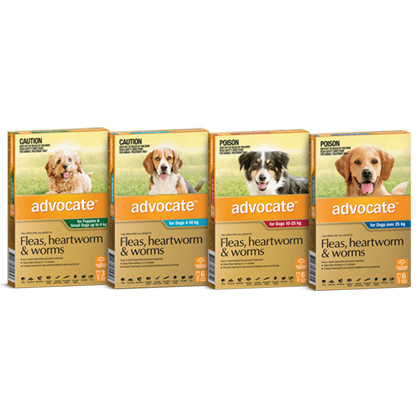Learn about the most common types of worm species that infect dogs and cats, how to spot the symptoms of worms, and how to help keep your pet protected.
All about worms: common intestinal parasites in dogs and cats
Intestinal worms are more than just a nuisance that can cause your dog or cat discomfort – they can also pose serious health risks to your pet, you and your family. As a pet owner, the main intestinal worm species you should be aware of are roundworms, tapeworms, hookworms, and whipworm. Knowing how your pet can be exposed to these intestinal parasites is important in helping reduce the risk to yourself and your family, too.
Roundworms
Long, white and spaghetti-like, roundworms are common intestinal worms found in both cats and dogs.
- How do dogs and cats become infected? Puppies can be infected in utero (i.e. before birth), and nursing puppies & kittens can also be infected by drinking milk containing infective larvae. Infected pets pass roundworm eggs out through their faeces, and the eggs find their way into the soil. Dogs & cats can accidentally ingest these eggs when they are sniffing around the ground or playing with a toy in a contaminated area.
Roundworm eggs in the environment can also be ingested by small animals such as birds and mice. These animals are referred to as transport hosts, where the roundworm larvae lie inactive in the host’s tissues. Dogs and cats that hunt become infected when eating an infected transport host, thereby indirectly ingesting the roundworm larvae.
- Symptoms: Adult dogs and cats may show no obvious signs, but puppies and kittens are more severely affected and can even die from heavy roundworm burdens. Symptoms include vomiting, diarrhoea, lethargy, poor coat condition, and young animals may display a potbelly and slow growth. Puppies infected with large number of larvae can show signs of respiratory disease such as pneumonia.
- How do people become infected? If people accidentally swallow roundworm eggs, the larvae of this parasite can travel around the body causing serious disease such as damage to the lungs, liver disease and even blindness.
Tapeworms
Tapeworms are segmented worms that live in the small intestine of infected pets. Tapeworms can sometimes be seen in the pet’s faeces, or around the anus, resembling tiny crawling rice grains.
- How do dogs and cats become infected? Adult tapeworms live in the intestines of dogs & cats. Segments containing eggs are released from the worm and pass out in the pet’s faeces. Depending on the type of tapeworm, secondary or intermediate hosts such as grazing animals, rodents, lizards or flea larvae ingest the eggs. Worms mature inside these intermediate hosts, and pets are infected by eating the host. The most common tapeworm in dogs & cats is the ‘flea tapeworm’ (Dipylidium caninum). As its name suggests, it is contracted when pets swallow infected fleas. Dogs can get infected with the hydatid tapeworm (Echinococcus granulosus), which pose a serious risk to humans.
- Symptoms: Most infections in pets are asymptomatic. However, they can cause irritation around the bottom, unexplained weight loss, diarrhoea and vomiting.
- How do people become infected? Depending on the type of tapeworm, people become infected when they ingest tapeworm eggs (hydatid tapeworm), or accidentally swallow an infected flea (flea tapeworm). While this is uncommon, in the case of hydatid tapeworm it can be life-threatening. Hydatid tapeworm eggs can lodge in various organs in humans (e.g. liver, lungs and even the brain), and develop into large fluid filled cysts. Hydatid disease is difficult to treat and control, so reducing the likelihood of exposure by regularly deworming your dog, preventing your dog from scavenging and maintaining good hygiene practices is very important. Flea tapeworm rarely causes disease in humans, but symptoms can include vomiting and diarrhoea, especially in children.
Hookworms
Hookworms are found in dogs and cats. These worms latch on to the lining of your pet’s intestine with their sharp teeth and feed on blood.
- How do dogs and cats become infected? There are a few different ways that your pet can become infected with hookworm. Infected dogs & cats will regularly pass faeces containing hookworm eggs into the environment. The eggs hatch into larvae that can survive in the soil for weeks. Other pets can either eat these larvae (for example, if soil gets onto their paws and they groom themselves), or the larvae can penetrate the pet’s paws directly from the soil and then migrate their way through the body to the intestine.
Nursing puppies can also be infected by drinking milk containing infective larvae.
Hookworm larvae in the environment can also be ingested by small animals and insects such as birds, mice, lizards, cockroaches etc. These animals are referred to as transport hosts, where the hookworm larvae lie inactive in the host’s tissues. Dogs and cats that hunt become infected when eating an infected transport host, thereby indirectly ingesting the hookworm larvae.
- Symptoms: Adult animals may not show any symptoms. Symptoms are more commonly seen in younger animals and can include diarrhoea containing blood, which may lead to anaemia. In severe infections, this can lead to death if not treated.
- How do people become infected? If people walk barefoot over soil containing hookworm larvae, the larvae can burrow into the skin and cause intense itching & irritation (dermatitis), with the feet being most commonly affected. Occasionally, hookworm larvae can migrate to the intestine, resulting in severe abdominal pain.
Whipworm
In Australia, whipworm infects dogs, not cats. As the name suggests, whipworm resembles a whip, with a thicker front end and a longer, thinner back end.
- How do dogs become infected? Infected dogs pass whipworm eggs into the environment via their droppings. These eggs are extremely hardy and can survive for several years, acting as a source of infection for dogs for a long period of time. Dogs become infected when they accidentally ingest these eggs e.g. while playing and rummaging around in the grass etc.
- Symptoms: If low numbers of worms are present, dogs may not show symptoms, but heavy infestations can result in significant damage to the intestines, which can lead to diarrhoea containing fresh blood (bright red) and mucous, and dogs can strain to pass faeces. Severe infections result in weight loss, dehydration, anaemia, and in the most extreme cases, death.
- How do people become infected? Canine whipworm is not considered a zoonotic threat – in other words, there is little risk of catching this parasite by coming into contact with infected faeces.
How to prevent worms in your pet
Regularly deworming your dog or cat is advisable, not just for the health of your pet, but to help protect you and your family from the potentially harmful effects of parasites.
The usual recommendation for adult cats and dogs is to deworm them at least once every three months to control intestinal worms and help reduce the risk of human infections. In some cases, such as with hydatid tapeworm in dogs, monthly deworming is recommended. Always consult your veterinarian to ensure your pet is on an adequate deworming regimen. Appropriate hygiene practices are also essential in minimising the risk these parasites pose to humans.
There are a variety of options available for deworming your pets. Deworming your pet regularly with MilbemaxTM protects them against major gastrointestinal worms. Monthly treatment with Milbemax also protects your pet against heartworm disease.
Another option is AdvocateTM. Advocate is a monthly spot-on that not only protects dogs & cats against most gastrointestinal worms, it also offers protection against fleas and heartworm. With regular monthly use, Advocate kills worms at the time of treatment and is also able to prevent new worm infestations between treatments.
Armed with your newfound knowledge of worms, as well as proper preventative measures, you can ensure your pet remains healthy, fit and protected from the nasty effects of intestinal worms.

Advocate for dogs
Advocate provides fast relief from fleas, prevents deadly heartworm and helps protect your dog and your family from most intestinal worms









